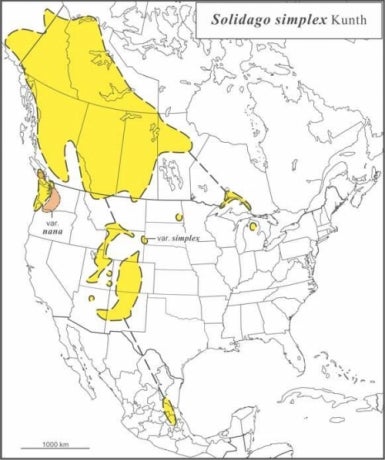Department of Biology
ESC 350
200 University Ave. W
Waterloo, Ontario, Canada N2L 3G1
Phone: (519) 888-4567 ext. 32569
Fax: (519) 746-0614
Solidago simplex Kunth in the revised sense (Semple & Peirson 2013) is native to North America from Alaska to Mexico and across Canada to northern Ontario. The species been included in S. spathulata and as a separate species under the synonym S. glutinosa. Cronquist (1947) included S. chlorolepis, S. gillmanii, S. racemosa, and S. randii under S. glutinosa as varieties in two subspecies. Ringius (1987) added an additional variety treated here as S. ontarioensis. Then, the entire infraspecific classification was transferred to S. simplex by Ringius in Ringius & Semple (1991) following Nesom's (1989) discovery that S. simplex was the oldest species name for the S. glutinosa complex. Peirson et al. (2012) presented arguments why each of the varieties should be treated as species and Semple & Peirson (2013) proposed a revised classification for the S. simplex complex, which is followed here.

The cytogeography of S. subsect. Humiles and possible alternative classification schemes were discussed by Peirson, Reznicek and Semple (2012). Peirson et al (2013) discussed haplotype variation patterns in the subsection and possible ages for older taxa.
The species is now reduced to two taxa, the typical one widely distributed and the other occurring at higher elevations in the northern Cascade Mts.
Semple, J.C. , and J.A. Peirson. 2013. A revised nomenclature for the Solidago simplex complex (Asteraceae: Astereae). Phytoneuron 2013-41. 1-5.
Peirson, J.A., C.W. Dick and A.A. Reznicek. 2013. Phylogeography and polyploid evolution of North American goldenrods (Solidago subsect. Humiles, Asteraceae). J. Biogeography. 40: 1887–1898.
Last updated 2 November 2013 by J.C. Semple
© 2013 J.C. Semple, including all photographs unless otherwise indicated.




